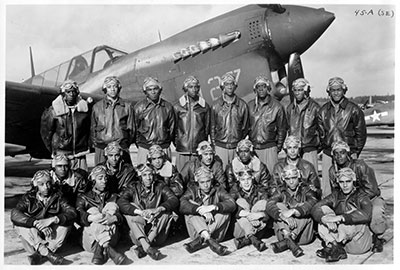Who are the Tuskegee Airmen?

NPS
Who are the Tuskegee Airmen? Did they all come from Tuskegee? Were they really the first African American fighter pilots in the US Army Air Corps during World War II (WWII)? These are just some of the questions that visitors ask at the Tuskegee Airmen National Historic Site, the birthplace of the Tuskegee Airmen. Yes, the Tuskegee Airmen fought in WWII.
Yes, they were the first African American fighter pilots and crew in the US Army Air Corps, and no, they were not all from Tuskegee. The Tuskegee Airmen were trailblazers, pioneers and leaders in the fight against fascism and racism. These men were the crème of the crop, many of whom already had bachelors and masters degrees when they first began flight training in July of 1941. These men and women fought two wars and won both of them with skill and bravery.
Many visitors to the site think of the movie “Red Tails” or the movie “Tuskegee Airmen” when they initially visit the site. Both of those movies do a great job highlighting the accomplishments of the airmen, but the story and legacy of the airmen is so vast that it would be hard to put all of it into one movie. The legacy of the Tuskegee Airmen spans the time before, during, and after WWII.
All of the 994 Tuskegee Airmen pilots who graduated from advanced pilot training at Tuskegee Army Air Field went through a strenuous training process of eight weeks of primary training followed by another eighteen weeks of basic and advanced flight training. These men were up at 5:00 am and did not go to bed at night until after 10:00 pm, Monday through Saturday, for eight months. The airmen endured the pressure of being the first African American fighter pilots and being in the segregated American South, along with many other hurdles that they had to overcome, and in spite of those hurdles, they became legends.
Despite the many hours of flight training, and the enemies that they faced at home and away, the Tuskegee Airmen still have one of the best records out of any fighter group during WWII. The airmen flew over 180 combat sorties (missions) without losing a single bomber. When the airmen were first deployed during WWII they did not have the best or up to date airplanes to use. However, the crew chiefs, line chiefs, and mechanics were very creative in finding ways to fix the airplanes so they could head back out to complete the missions that they were assigned. This illustrates that the airmen weren’t only the pilots who flew combat missions overseas, but they were also the support men (overseas combat) and women (stateside preparations, civilian mechanics) who make up the legacy of the Tuskegee Airmen.
The legacy of the Tuskegee Airmen is about more than the airplanes they flew, their combat records, or their fame. It is about overcoming obstacles no matter how large or complex they are. The Tuskegee Airmen prescribed to the theory of winning a “Double Victory”, which meant winning the fight against fascism and racism. Many of the visitors that visit the Tuskegee Airmen site don’t initially make the connection between the success of the airmen and the role they played in the Civil Rights Movement. The Airmen, along with the various other African American units that fought during WWII not only demonstrated that African Americans were willing to fight for the freedom, but they were also willing to fight under strenuous (racial) conditions, with the hope that their actions would help to open doors for all Americans back home in the United States.
The Tuskegee Airmen helped to pave the way for African Americans to hold prominent positions in the United States military, but also in the United States as a whole. Our very own President Barack Obama has stated “My career in public service was made possible by the path heroes like the Tuskegee Airmen trail-blazed.” We here at the Tuskegee Airmen National Historic Site challenge you to think about what it means to be a trailblazer or a pioneer, what it means to stand for freedom and, what it means to contribute to change societal wrongs. We also challenge you to not only look at history as events that happened many years ago, but to look at historic events as the bridge that connects our past to the present that we live in today.
Tags
- tuskegee airmen national historic site
- tuskegee institute national historic site
- tuskegee airmen
- world war ii
- breaking barriers
- african american
- african american soldiers
- african american history
- aviation history
- tuskegee airmen national historic site
- civil rights
- aviation figures
- military aviation
- aviation firsts
